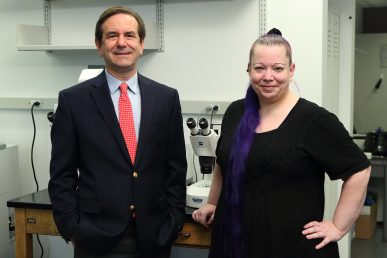DOD grant to test promising treatment for triple-negative breast cancer
A unique cell surface protein found on triple-negative type breast cancer cells called JAG1 is a promising new therapeutic target for this hard-to-treat and highly metastatic type of breast cancer, according to researchers at the University of Illinois at Chicago.
Jan Kitajewski, professor and head of physiology and biophysics at UIC, and his colleagues are working on developing a small drug molecule that can block JAG1.

Jan Kitajewski (left), professor and head of physiology and biophysics, UIC College of Medicine, and Naiche Adler, research scientist, physiology and biophysics
(Photo: Jenny Fontaine)
Kitajewski, who is also associate director for basic science of the University of Illinois Cancer Center, has received a three-year $1.17 million Department of Defense grant to develop this new therapy to treat triple-negative breast cancer, so named because it does not contain three of the most common types of receptors that fuel most breast cancer growth — estrogen, progesterone and the HER-2/neu.
About 40,000 women in the U.S. are diagnosed with triple-negative breast cancer each year. African-American women are most likely to develop triple-negative breast cancer, which is typically treated with aggressive chemotherapy or radiation, not with hormone therapy, the traditional course of action to fight hormone-positive breast cancers. New targeted therapies for triple-negative breast cancer are “badly needed to improve the quality of life for patients, and many of them reside in our community,” Kitajewski said.
“Triple-negative breast cancer is more likely than other breast cancers to recur and spread to other parts of the body, such as the brain, lungs, liver or bones,” he said. “We need to find a way to block metastasis, because it is often difficult or impossible to treat once it spreads. In many cases, this leads to death.”
The presence of JAG1 on the surface of triple-negative breast cancer cells typically means poor outcomes for patients. When a receptor called notch binds to JAG1, it activates a form of cellular communication through what is known as the notch signaling pathway. Notch signaling is believed to help tumors grow by attracting new blood vessels to supply oxygen and nutrients to the tumor.
New data from the Kitajewski lab suggests notch also promotes metastasis, the spread of cancer to other organs. Researchers have tried to block notch signaling with chemical compounds, but these cause severe gastrointestinal toxicity.
Kitajewski and his laboratory have developed a new class of therapeutic proteins, called notch decoys. They work by binding to JAG1 and preventing it from binding to true notch receptors, thereby dampening down the activation of the notch signaling pathway. Tests have been conducted using notch decoys on human tumors implanted into mice. Results have shown that JAG1-specific notch decoys reduce tumor growth, tumor blood vessels, and the ability of those vessels to carry blood and oxygen to the tumor, Kitajewski said. The treatment also did not cause gastrointestinal toxicity in the animals.
A new, more advanced JAG1-inhibiting notch decoy, optimized for use in humans, has been developed by Kitajewski and his colleague, Naiche Adler, a research scientist in his laboratory. The new grant will support the testing of the advanced notch decoy in mice with human triple-negative breast cancer tumors.
“We believe the JAG1-notch decoy will have fewer side effects than aggressive chemotherapy, radiation, or other notch inhibitors,” he said. “Most importantly, this therapy may block metastases to new organs, which would substantially reduce breast cancer mortality. We’re excited to receive this new funding as it will facilitate the fight against this aggressive form of breast cancer.”
